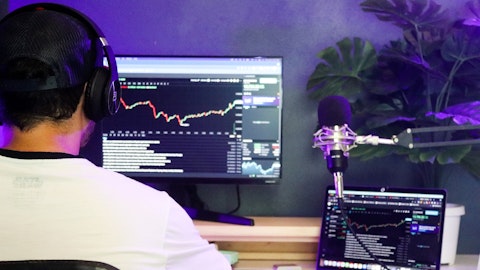Altimmune, Inc. (NASDAQ:ALT) Q4 2023 Earnings Call Transcript March 27, 2024
Altimmune, Inc. isn’t one of the 30 most popular stocks among hedge funds at the end of the third quarter (see the details here).
Operator: Good day, ladies and gentlemen, and welcome to the Altimmune Inc. Full Year and Fourth Quarter 2023 Financial Results Conference Call. [Operator Instructions] As a reminder, this call is being recorded. I will now introduce your host for today’s conference call, Rich Eisenstadt, Chief Financial Officer of Altimmune. Rich, you may begin.
Rich Eisenstadt : Thank you, Michelle, and good morning, everyone. Thank you for participating in Altimmune’s Full Year and Fourth Quarter 2023 Financial Results and Business Update Conference Call. Members of the Altimmune team joining me on the call today are Vipin Garg, our Chief Executive Officer; Scot Roberts, our Chief Scientific Officer; and Scott Harris, our Chief Medical Officer. Following the prepared remarks, we will hold a question-and-answer session A press release with our lean mass preservation data and our full year and fourth quarter 2023 financial results was issued this morning and can be found on the Investor Relations section of the company’s website. Before we begin, I’d like to remind everyone that remarks about future expectations, plans and prospects constitute forward-looking statements for purposes of safe harbor provisions under the Private Securities Litigation Reform Act of 1995.
Altimmune cautions that these forward-looking statements are subject to risks and uncertainties that could cause actual results to differ materially from those indicated. For a discussion of some of the risks and factors that could affect the company’s future results and operations, please see the risk factors and other cautionary statements contained in the company’s filings with the SEC. I’d also direct you to read the forward-looking statement disclaimer in our press release issued this morning and now available on our website. Any statements made on this conference call speak only as of today’s date, Wednesday, March 27, 2024, and the company does not undertake any obligation to update any of these forward-looking statements to reflect events or circumstances that occur on or after today’s date.
As a reminder, this conference call is being recorded and will be available for audio replay on Altimmune’s website. With that, I will now turn the call over to Dr. Vipin Garg, Chief Executive Officer of Altimmune.
Vipin Garg : Thank you, Rich, and good morning, everyone. We appreciate you joining us today for a discussion of our year-end and fourth quarter 2023 financial results and business update. We are excited about the 2023 achievements with pemvidutide, our GLP-1/glucagon dual receptor agonist, which is in development for the treatment of obesity and MASH, two important clinical indications. Altimmune achieved key milestones in the development of pemvidutide last year, including compelling positive data from our 48-week MOMENTUM Phase II obesity trial and initiation of the impact biopsy-driven Phase IIb trial in MASH. We’re also extremely pleased with the results of our body composition analysis from the MOMENTUM Phase II obesity trial of pemvidutide, showing that 74.5% of weight loss came from fat, and only [25.5%] from lean mass.
Our Chief Medical Officer, Scott Harris will review these results in greater detail shortly. The MOMENTUM trial showed that subjects receiving pemvidutide had a mean weight loss of 15.6%, and over 30% of subjects achieved 20% or more weight loss on 2.4 milligram dose of pemvidutide at week 48, along with robust reductions in BMI and serum lipids, as well as improvements in blood pressure without imbalances in cardiac events, arhythmias or clinically meaningful increases in heart rate. In addition, the impressive — in addition to the impressive body composition data further distinguishes pemvidutide from other compounds in development for the treatment of obesity. Turning to our impact biopsy-driven Phase IIb MASH trial, we are looking forward to announcing the top line 24-week results anticipated in the first quarter of 2025.
We are confident this trial will be successful considering the positive results from our 24-week Phase Ib trial of pemvidutide in subjects with MASLD, where a greater than 75% relative reduction in liver fat content was achieved at the 1.8 milligram and 2.4 milligram dosage at 24 weeks, along with robust reductions in ALT and cT1, both biomarkers of liver inflammation. A recently completed preclinical study demonstrating a direct anti-fibrotic activity of pemvidutide provides evidence of the potential second mechanism for reducing fibrosis in MASH patients. With that, I will now turn call over to our Chief Medical Officer, Dr. Scott Harris to discuss our data and clinical plans. Scott?
Scott Harris : Thank you, Vipin, and good morning, everyone. First, let me tell you about the compelling body composition analysis from the MOMENTUM trial, which showed that 74% of weight loss came from adipose issue, and only 25.5% due to lean mass, comparable to the effects historically associated with diet and exercise programs. These data are among the best results achieved with incretin-based obesity drugs. With an increasing number of anti-obesity candidates in development, there is growing evidence emphasis on the type and quality of weight loss where the ability to preserve lean body mass has been viewed as an important differentiator in the treatment of patients with obesity. Excessive lean mass loss has been associated with negative outcomes such as sarcopenia and bone fractures, especially in women and the elderly.
Additionally, we saw the participants in MOMENTUM preferentially lost visceral fat over subcutaneous fat an important result, as visceral fat like hepatic fat content increases metabolic dysfunction and is highly associated with increased cardiovascular risk. We expect to present a complete analysis of these body composition data at an upcoming scientific meeting. Keep in mind that these favorable body composition data only add to the improvements we observed in serum lipid profile. We’re up to 20% — up to a 20% reduction in total cholesterol, 21% reduction in LDL cholesterol and nearly 56% reduction in triglycerides were observed in MOMENTUM participants with elevated baseline serum lipids. This strengthens our view that pemvidutide has the ability to treat not only obesity, but its key morbidities like cardiovascular disease and MASH.
Recall that in our MOMENTUM Phase II obesity trial, subjects receiving 2.4 milligrams pemvidutide had a mean weight loss of 15.6%, and over 30% of these subjects achieved 20% or more weight loss at week 48. What was equally exciting is that the 2.4 milligram weight loss curve remained linear with no indication of plateauing at week 48. Along with the previously mentioned effects on serum lipids, pemvidutide also demonstrated improvements in blood pressure within imbalances in cardiac events, arrhythmias or clinically meaningful increases in heart rate. Glucose homeostasis was maintained with no significant changes in fasting glucose or hemoglobin A1C. Dr. Louis Aronne, lead investigator for the MOMENTUM trial will present the results of this trial at an upcoming scientific conference.

Now let me talk about the IMPACT biopsy-driven Phase IIb trial. Approximately 190 subjects with or without diabetes are being randomized 1:2:2 to 1.2 milligrams, 1.8 milligrams or 1.8 milligrams pemvidutide placebo administered weekly for 24 weeks. The key endpoints will be MASH resolution or fibrosis improvement after 24 weeks of treatment with subjects followed for an additional 24 weeks for assessment of safety and additional biomarker responses. Enrollment is going well and we expect to have top line results of the IMPACT trial in the first quarter of 2025. We believe that the rapid rate of enrollment reflects the eagerness of MASH patients to achieve significant weight loss in addition to treatment of their liver disease. This past fall, we also reported that FDA granted Fast Track designation for pemvidutide for the treatment of MASH based on the robust and rapid reduction in liver fat content and biomarkers of fiber inflammation observed in our Phase Ib [indiscernible] trial.
We look forward to working closely with the agency in the development of pemvidutide for this important indication. Finally, turning to our Phase II clinical trial of HepTcell and chronic hepatitis B, the overall response in the recently completed trial was insufficient for further development so we are stopping all further development. With that, I will now turn the call over to Dr. Scot Roberts, our Chief Scientific Officer, to discuss some recent preclinical findings. Scot?
Scot Roberts : Thanks, Scott. Good morning, everyone. I’d like to tell you about 2 studies that we’ve recently completed. The first represents an important development related to the therapeutic mechanism of pemvidutide for NASH. We now have evidence for a direct anti-fibrotic effect of pemvidutide in reducing liver fibrosis. The preclinical model used to chemical treatment to induce fibrosis as opposed to more typical mass models based on obesity and high liver fat content. The chemical model allows for the separation of direct anti-fibrotic effects from the activity following potent de fating of the liver by pemvidutide. The data showed a significant 33% reduction in the amount of fibrosis after only 2 weeks of pemvidutide treatment in the presence of continued chemical exposure.
These data bolster our optimism about obtaining a successful 24-week readout in the IMPACT trial in the first quarter of 2025. In a separate unrelated study, we demonstrated that pemvidutide treatment increased the efficiency of an important process called reverse cholesterol transport or RCT. RCT is the process by which excess cholesterol is removed from tissues and eliminated from the body. It is widely understood that LDL can cause the accumulation of cholesterol in the arteries, leading to atherosclerosis and increased risk for cardiovascular event. In the study, we demonstrated that pemvidutide treatment was able to increase the amount of cholesterol eliminated by the liver by 300% while lowering serum cholesterol levels. Clinically, we have shown that pemvidutide nnot only lowers serum LDL cholesterol by up to 21%, but also shifts the size of LDL particles towards larger particle sizes that cannot enter the vasculatures easily.
The demonstration of increased RCT activity to get reductions in serum lipids and liver fat support a potentially broad role for pemvidutide improving cardiovascular risk in addition to its robust weight loss effects. I will now hand the call over to Rich Eisenstadt to give an update on our third quarter financial results. Rich?
Rich Eisenstadt : Thank you, Scot, and good morning, everyone. It’s actually our fourth quarter financial results. For today’s call, I will be providing a brief update on Altimmune’s full year and fourth quarter 2023 financial and operating results. More comprehensive information will be available in our Form 10-K to be filed with the SEC later today. Altimmune ends the fourth quarter of 2023 with approximately $198 million of cash, cash equivalents and short-term investments, compared to $184.9 million at the end of 2022. We project our existing cash funds us into the first half of 2026, which fully funds our IMPACT trial and MASH, including the anticipated Q1 2025 readout of top line 24-week biopsy data. Turning to the income statement.
Revenue was negligible in the fourth quarter and full years 2023 and 2022. Any revenue reported during such periods was for indirect rate adjustments on a government contract that we are closing out. Research and development expenses were $16.9 million in the fourth quarter of 2023 compared to $19.2 million in the same period of 2022. Approximately $11.4 million of this total for the fourth quarter of 2023 were direct expenses for the conduct of our clinical programs, including $10.3 million in direct costs related to development activities for pemvidutide, and $1.1 million in direct costs related to development activities for HepTcell. R&D expense in the fourth quarter of 2022 included $13.4 million in direct expenses associated with the development of pemvidutide and $1.9 million in direct expenses related to HepTcell development activities.
Research and development expenses were $65.8 million in full year 2023 compared to $70.5 million in the prior year. In full year 2023, we incurred $35.8 million in direct costs associated with the IMPACT and MOMENTUM trials for pemvidutide, and $6.6 million in direct costs associated with the HepTcell campaign. General and administrative expenses were $4.3 million and $3.8 million in each of the fourth quarters of 2023 and 2022. For the full year 2023, general and administrative expenses were $18.1 million versus $17.1 million for full year 2022. The $1 million increase was primarily due to increased stock compensation expense as well as additional labor-related costs in 2023. An impairment loss on intangible assets of $12.4 million was recognized during the fourth quarter of 2023 related to the acquired in-process research and development or IP R&D asset associated with HepTcell.
As previously discussed, the overall response in the Phase II trial is deemed to be insufficient to warrant further advancement in clinical trials, and as a result, we have stopped any further development related to HepTcell. Our quarterly noncash operating expenses for the fourth quarter was — of 2023 was $15.1 million, including the IP R&D write-off or $2.6 million for just the recurring expenses. For the full year, total noncash operating expenses was $23.8 million or $11.3 million for just the nonrecurring items — I’m sorry, for the recurring items. I apologize. Net loss for the 3 months ended December 31, 2023, was $31.6 million or $0.54 net loss per share compared to a net loss of $21.7 million or $0.43 net loss per share for the fourth quarter of 2022.
The increase in net loss in the quarter was primarily attributable to the $12.4 million noncash impairment charge, partially offset by $2.3 million lower research and development expenses. Net loss for the year end December 31, 2023, was $88.4 million or $1.66 net loss per share compared to $84.7 million or $1.81 net loss per share for the year ended December 31, 2022. The increase in net loss for the year is primarily attributed to the noncash impairment charge, partially offset by lower research and development expenses in 2023 and a $4.5 million increase in interest income earned on our cash equivalents and short-term investments. I will now turn the call back over to Vipin for his closing remarks. Vipin?
Vipin Garg : Thank you, Rich. Operator, that concludes our formal remarks. We would like to open the line to take questions. Could you please instruct the audience on Q&A procedure?
See also 20 Biggest Financial Mistakes That Young Adults Make and 16 Countries with the Most Number of Islands.
Q&A Session
Follow Altimmune Inc. (NYSE:ALT)
Follow Altimmune Inc. (NYSE:ALT)
Operator: [Operator Instructions] Our first question comes from Yasmeen Rahimi with Piper Sandler.
Yasmeen Rahimi : I think the first question that we have been getting is, given the continued desirable product profile of pemvidutide, a lot of investors would like to get a little bit more update on where you are with parts discussions currently? That’s question number one. Question number two is, have you had the opportunity to engage with the agency in regards to the Phase III design for obesity and what those would look like? And then the third one, how could we think — you showed really compelling lean mass preservation results at week 48, how could we think about this magnitude to be further improved over time in patients? And thank you for allowing me to ask these questions.
Vipin Garg: Scott, do you want to take the questions first, and I will come back to the partnering question.
Scott Harris: Okay, Yasmeen, so I’ll take your second and third questions, and then Vipin will answer the partnering discussions. So our plan is to have a meeting with the agency in the second half of this year to discuss our Phase III program in obesity. And at that time, we’ll have final conclusions about the design of the program and the trials. But the template for this has been established with other programs, and we think that we would have a similar development program in Phase III. Regarding the body composition data and the results that we saw at week 48, yes, the results are compelling and among the best in class for incretin agents and very similar to the percentage of lean mass seen with healthy weight loss, with diet and exercise, and this is what obesity experts are emphasizing, is to get the lean loss down to avoid the comorbidities of losing lean mass.
As you may be aware from the bariatric and weight loss literature, the percentage of weight loss that is lean mass decreases over the course of time. So whereas we were 25.5% at week 48, there’s potential to go to even lower numbers, the subjects were followed out to week 68 to week 72. Vipin?
Vipin Garg: Yes. Yes. In terms of partnering discussions, the status of partnering discussions, we are having robust discussions with companies that are both scientific and technical in nature as well as business-related discussions. As you can imagine, each company has their own particular focus, but they’re all appropriate, they all appreciate pemvidutide comprehensive and differentiated profile. So overall, we are pleased with the scientific and business discussions to date, and we will update as things develop in the future.
Operator: Our next question comes from Seamus Fernandez with Guggenheim.
Seamus Fernandez : Appreciate the opportunity to ask questions here. The partnering discussions, Vipin, you mentioned scientific and technical discussions but also business discussions. It seems to me, this is predominantly a business discussion at this point. So I’m just trying to better understand the commentary of differentiating those two. If there are scientific and technical discussions, what are the scientific and technical debates that remain for pemvidutide in the context of an obesity program? And in the past, on partnering, you’ve commented that, perhaps, there will be a separation of the opportunity for obesity being with a partner, but perhaps having NASH or MASH move forward exclusively with Altimmune. Do you still believe that, that is a realistic partnering discussion given the fact that we’ve now seen hint that tirzepatide has an opportunity potentially to impact fibrosis?
And we have another competitor molecule in servidutide that’s likely to present data in the near term with regard to their own potential fibrosis benefits and both programs have a very robust obesity program, either planned or well underway.
Vipin Garg: Yes, Seamus. There’s a lot to unpack there. So let me — let me take one at a time, and if I have not completely address your questions, please come back and repeat the remaining part. But look, in terms of discussions with partners, as you can imagine, the different companies have different focus, but everybody is appreciating the cardiovascular benefit of pemvidutide. And that’s what is driving these discussions. It’s obesity with cardiovascular benefit, all of the things we’ve been talking about in terms of the lipid profile, the serum lipids, the liver fat content and blood pressure. So all of these things combined, we believe, will have significant impact, not just people losing weight, but ultimately, the cardiovascular outcomes in these.
So a lot of the discussions are driven by that. We’re very encouraged because that’s the value proposition that we think we bring to the table and people are getting it, people are appreciating it. And the question is, is this an obesity partnership, cardiovascular partnership or MASH partnership or all of those combined together. So in terms of MASH, as you know, we are moving forward with the with the program. We’ll have our Phase IIb data in the first quarter of 2025 and that will drive that program further. Clearly, in MASH, we are highly differentiated, both in obesity and MASH, we are highly differentiated. But in terms of other glucagon program being there, we are differentiated from that also. And maybe, Scott, you can comment on that.
Scott Harris: Yes, Seamus. We’re encouraged by the results with the other compounds in MASH. You mentioned tirzepatide and also servidutide. We believe that the effects seen with servidutide are due to the glucagon component. And we’d remind you that molecule is heavily biased to GLP-1 away from glucagon, and there’s not as much glucagon in the molecules, and our molecule where we have one to one. We feel so confident about the potency of our molecules that we’re actually willing to break from the pack, read out the endpoint of 24 weeks. The other compounds are reading at considerably longer periods of time. Also with regards to servidutide, reminds you that the adverse event dropout rate in that trial was very, very high despite the fact they titrated for 20 weeks.
So we don’t think the tolerability profile with our compound is comparable. But we think that based on all of our biomarkers, all of the data that we generated up to date, we’re going to have a very, very potent readout and the confidence that we could actually read that out of 24 weeks rather than 48 weeks represents our confidence in the molecule.




